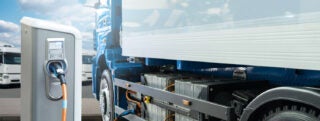- Resources
- Gearing up for electric trucks: How investors can tackle transport emissions
Resources
Gearing up for electric trucks: How investors can tackle transport emissions
Published: February 7, 2022 by Andrew Howell
Across the U.S., trucks play a crucial role in carrying parts and products to stores and consumers. The vast majority of these trucks are heavy polluters, making trucking a major component of the carbon emissions linked with companies across the supply chain – as well as those of their investors.
The internal combustion engines in medium- and heavy-duty trucks collectively generate 7% of U.S. CO2 emissions – more than air, rail and maritime freight combined. Truck exhaust also contains particulate emissions, disproportionately damaging the health of those who live and work near major trucking corridors, typically low-wealth communities and communities of color.
For corporations and investors with net zero or ESG goals, addressing trucking emissions is crucial to hitting those targets.
The good news is that zero-emission trucks have become a credible alternative to the pollution-spewing diesel vehicles on the road today. ZE trucks are increasingly available, at a competitive cost of ownership, thanks to major advances in batteries and other supporting technologies. In many respects, these trucks are superior to the diesel vehicles they replace – quieter, cleaner-operating, with better acceleration and requiring less maintenance. The International Energy Agency forecasts rapid growth in ZE truck sales, reaching 170,000 units in the U.S. in 2025 and nearly 1 million units in 2030 – a 45% compound annual growth rate.
The trucking transition is already under way, and leading companies are purchasing vehicles and piloting electric charging configurations in anticipation of when fleet turn-over begins in earnest. These early moves are instructive in showing how companies – both those that provide trucking services (carriers) as well as those that rely on trucking services to move goods (shippers) – expect to adapt to the different operational profile of ZE vehicles.
For companies, addressing trucking emissions not only reduces climate and health impacts, but also represents best practice from a risk management perspective. For investors, engaging with companies on trucking can make progress on portfolio emissions, as well as help identify sector leaders.
In a new report, “Into the Fast Lane: Investing in the future of zero emission trucking,” we dive into considerations for investors as they engage with portfolio companies about electric trucking. Drawing on EDF’s work with businesses, climate and health advocates, federal and state regulators, and other stakeholders, we identify key questions investors can ask shippers and carriers, as well as commitments and disclosures that are central to gauging preparedness for the trucking transition. These include: 1) commitments for zero-emission fleet and trucking services by 2040; 2) interim goals with application-specific targets; 3) a preference to deploy zero-emission trucks in pollution-burdened communities first; and 4) advocacy for clean transport policies at a federal and state level.
Due to the long-lived nature of transportation assets and infrastructure, actions taken now will have decades-long consequences for individual companies, the climate and public health. Investors looking to manage ESG risks in their portfolio should address trucking and push companies to adopt a “pedal to the metal” approach


